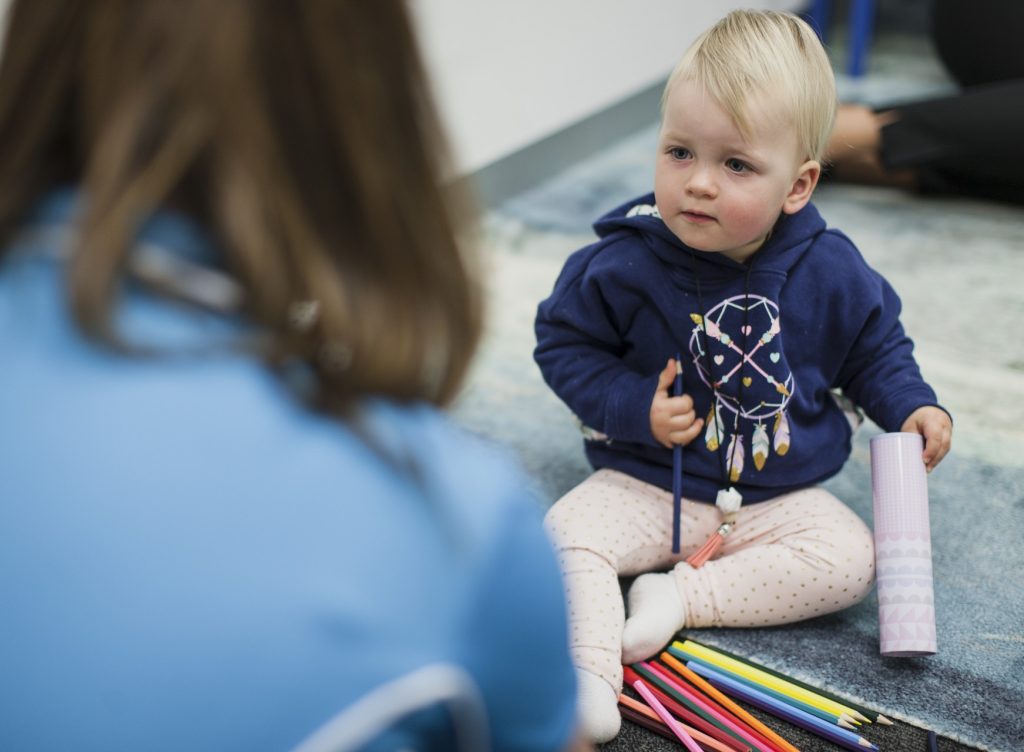
Working as a speech pathologist, one of the most common questions I get asked when working with little ones is “How can I help my child say more words?” If you have noticed your child struggling with communication, I am sure this is a question that you are asking yourself, too.
How can I help my child say more words?
Children develop their language by actively listening to the words used in their everyday environments, by family and friends, by talking to others, and by exploring with sounds and words. Therefore, a child’s first words are learnt in interactive environments. The more words that they are hearing, along with the repetition of these words/phrases, the more likely your child will be able to pick up and start using new words.
Don’t expect your child to attempt to repeat a word after hearing it on one occasion. Repetition and exposure are essential to your child’s language development and to developing their lexicon or personal dictionary.
Creating opportunities to communicate through play for early intervention is the most critical aspect for language acquisition in younger children. These opportunities can be created within our everyday environments. Kern speech therapists and child psychologists can provide you with advice. Get in touch here.
What are some strategies I can use at home to create these opportunities?
Withholding objects from an activity.
Select a familiar activity for your child that requires specific objects to complete the task. For example, if communication through play with paint is your goal, only give your child the paint brush, withhold paint. Wait for your child to initiate conversation or request the paint through pointing or through verbally requesting it. Familiar activities ensure a higher success rate.
Doing the unexpected.
Do the unexpected whilst completing an everyday routine and observe whether your child comments or tries to communicate with you. For example, when brushing your child’s teeth you could brush your child’s teeth without toothpaste or when putting on your child’s shoes, put the shoes on without socks.
Providing forced options.
Providing your child with forced options increases his or her need to request for the desired object during play. You can provide forced options by simply holding out two objects. For example, you can hold out a car or a ball and ask them “would you like the car or ball?” This gives the child a model of the word and aids their verbal attempt.
Focus on “Power Words”.
Power Words are simple words which are frequently used in one’s everyday environment. Power words are the building blocks or foundation for your child’s language development. Some of these power words include the following: more, mine, down, up, mum, dad, want, push, eat, faster and go.
When selecting Power Words:
- Start simple – select words that are easy to pronounce, or that contain sounds that should be acquired at the foundational stage of speech. Some earlier developing sounds include /m/, /p/, /b/ and /w/. For example – more, mum, bye, milk, ball, book.
- Build variety – try using a wide range of nouns (naming words) and verbs (action words). Expanding the naming of objects with the associated verbs helps develop your child’s sentence production and length. For example “more milk’, ‘push car’, ‘more bubble’, ‘up mummy’, ‘go car’, ‘mummy eat’.
- Learning through play – the constant repetition and exposure to these words in simple short sentences helps stimulate more speech.
Remember to model words as you play with your little one. For example:
Child: “Playing with bubbles”
Parent: “bubble, big bubble”
Child: “Blowing the bubbles”
Parent: “blow bubble”
Child: “pop”
Parent: “pop bubble” or “pop big bubble”
Teach the power of communicating through words not tantrums.
Using the simple strategies mentioned above will teach your child the power of communication, enabling your child to understand that if they produce the word of the desired object it will be given. However, if they stand and cry then nothing will happen.
Remember to try, if possible, not to pay attention or give them the toy if they cry or throw tantrums, as this does not teach them to be effective communicators. As previously mentioned, you can model the word or give them forced options and see if they imitate.
Give praise for good attempts – even if the words are not perfect.
It is important that praise is given promptly if the word you are asking your child to produce is attempted, even if not correctly articulated.
At the end of the day you want your little one to build up the confidence to continue with their process of language development, and not too easily get frustrated or discouraged and give up. So let’s recap on how to help your child communicate and acquire new language:
- Use repetition and exposure to build the foundation of your child’s language development and personal dictionary.
- Create opportunities to communicate through everyday activities and play.
- Use strategies to prompt communication, such as withholding objects from an activity, doing something unexpected, or giving forced options.
- Focus on ‘Power Words’ – Simple, frequently used words.
- Teach the power of communicating through words not tantrums.
- Give praise for good attempts – even if the words are not perfect.
Kern Health has a wide selection of specialists including child psychologists, physiologists and child speech therapists. Get in touch here for more information.